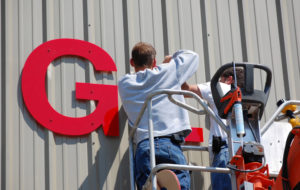
Anyone in the signage business knows that signs come in all shapes and sizes. Sometimes they are attached directly on a building, and sometimes they’re on an awning. Other times, the sign may be a pile-on sign at the edge of a property, or even a tiny sign installed within a parking lot to give drivers directions through a campus. Are these signs “improvements” to the property sufficient to justify filing a mechanics lien claim?
Over the past few months, I’ve published a bunch of “Scenarios” posts that analyze whether certain work qualifies for a mechanics lien filing. These posts try to answer the burning “Can I File A Lien For This?” question by going through different scenarios that may occupy some gray area in the mechanics lien world.
Signage, in some circumstances, may actually be a gray area, because it’s not always a permanent fixture attached to an improvement, and each state may define the term “improvement” differently.
Generally speaking, if you install a sign directly to a building’s structure, such as the sign installation photographed at the top of this blog post, you should have a right to file a mechanics lien for the labor and materials. In such a case, the sign does improve the value of the property, and it is “permanently” affixed to the building. Of course it can be removed with effort, but anything can be removed. The test for permanency is usually whether the removal of the fixture will cause a lasting impression of some sort on the building. The removal of this sign will cause such an impression, as there will be drill holes in the storefront, and there would likely be some electrical wires hanging out that require accommodation.
What about other types of signs? Take, for instance, the “Cinema Taco” sign displayed to the right here.
This is a common sign installation in downtown areas or Main St type developments, where the sign hangs from a bar attached to the building. Installing one of these signs, depending on its complexity and weight, is almost as simple as installing a flag pole. Does this type of sign installation create a sufficient permanent attachment to the structure to justify the filing of a mechanics lien?
In the mechanics lien world, there is never a simple answer. Whether this qualifies for a mechanics lien claim is really going to depend on the wording of each state’s specific statute authorizing the mechanics lien. Since the mechanics lien right is created by statute, courts must look to the statute to decipher who is entitled to lien and who isn’t. Simply being involved in a construction project is not going to be enough to qualify. The specific work performed must fall within the law’s scope.
The only other type of sign I’d like to discuss is even more detached from the building. These signs, a photo of some examples provided to the left, are actually not attached to a building or improvement at all, but are simply on poles and installed in the ground besides or near a building. Sometimes, these signs are fabricated and installed at the time of a building’s original construction, other times, however, these signs are simply ordered and installed on their own and not in connection with any construction project at all. Can a mechanics lien be filed for the installation of these types of signs?
As you can see, signs present an interesting situation. Sometimes, they are very attached to structures, and other times they are only slightly attached or not attached at all. Sometimes, they may be installed during a construction project, but yet other times they may be ordered independently.
Every state has a spectrum of services, labor or materials protected by its mechanics lien laws. Some states are very strict about what can be liened, and other states have very broad language. The question with signage work is where exactly on the spectrum the sign installation falls. The general response is that in most states, the signage affixed to the building’s structure is likely going to qualify for a mechanics lien. And, in fact, in most states, the laws are written to protect even those pile-on signs or stand-alone signs on the property.
However, if you find yourself in a strict or narrow state, beware. Your sign work may not qualify.

